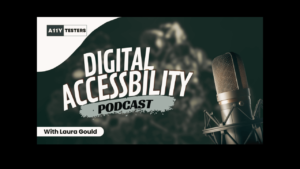In this growing digital world, the importance of accessible e-commerce has shifted from being just a required law to becoming an essential need for doing business. Making your online shop inclusive doesn’t only increase who can be your customers, but it also improves how people see and feel about your brand. This blog covers real-world examples of accessible e-commerce, provides input from professionals in the field, and points out important lessons learned during the process of incorporating accessibility actions.
Case Studies of Successful Accessible E-commerce Websites
1. Target
Target, which covered a class-action lawsuit in 2008 that questioned the accessibility of its website, is now a standard for accessible design. After dealing with this legal issue, Target changed its online space to show inclusivity by having:
- Clear, descriptive alt text for images.
- A well-structured heading hierarchy for seamless navigation.
- A keyboard-friendly interface that caters to all users.
- High color contrast for better readability.
- Closed captions for video content.
Key Takeaway: Legal challenges can serve as powerful motivators for improvement. Target’s experience emphasizes the importance of proactively addressing accessibility to avoid legal risks and enhance user experience.
2. Apple
Apple’s dedication to accessibility is evident across its products and its online store. The Apple Store is designed to accommodate a diverse range of users, including those with disabilities. Notable features include:
- VoiceOver compatibility for screen reader users.
- Customizable display settings for personalized experiences.
- Detailed accessibility information for each product.
- Live chat support with agents trained in accessibility.
Key Takeaway: Accessibility should be embedded into the core design process from the start. Apple’s comprehensive approach ensures that all users can interact with their site effortlessly.
3. Patagonia
Patagonia, a well-known name in the sustainability field, is also doing very good work with web accessibility. The website of this company follows WCAG (Web Content Accessibility Guidelines) rules and includes:
- Simple and intuitive navigation.
- Clear and readable text that enhances usability.
- Accessible forms and input fields.
Key Takeaway: Integrating accessibility with your brand values can build customer loyalty and trust. Patagonia’s accessible design aligns with its broader mission of doing good, resonating deeply with its audience.
4. Etsy
Etsy, a marketplace focused on handmade and vintage items, has embraced accessibility as part of its mission to keep commerce human. The site offers:
- ARIA landmarks for improved navigation.
- Skip-to-content links for easier access.
- Accessible form labels and error messages.
- Keyboard-accessible mega menus.
Key Takeaway: Accessibility should be part of your mission. Etsy’s focus on inclusive design helps ensure that all users can enjoy a smooth and engaging shopping experience.
Insights from Industry Leaders
1. Jenny Lay-Flurrie, Chief Accessibility Officer at Microsoft
Jenny Lay-Flurrie underscores the importance of empathy in design. “Understanding the diverse needs of our customers is essential,” she says. “By involving people with disabilities in the design process, we create better products for everyone.” Her advice highlights the value of user testing and engaging people with disabilities at every stage of development.
2. Haben Girma, Disability Rights Advocate and Lawyer
Haben Girma, the first deafblind graduate of Harvard Law School, advocates for a more inclusive digital world. “Accessibility is an opportunity, not a burden,” she states. Girma’s perspective emphasizes that accessible design is both an economic advantage and a social responsibility.
3. Lucy Greco, Web Accessibility Evangelist at UC Berkeley
Lucy Greco advises that accessibility should be integrated into the design and development process from the beginning. “It’s much easier and more cost-effective than retrofitting later,” she notes, underscoring the importance of proactive accessibility measures.
4. Mike Paciello, Founder of The Paciello Group
Mike Paciello reminds us not to overlook the checkout process. “Ensuring a smooth, accessible path to purchase is crucial for converting disabled customers,” he says, emphasizing that every step of the user journey must be accessible.
Read More: Accessibility in E-commerce Marketing
Lessons Learned from Accessibility Implementations
1. Start Early
The most common lesson from successful accessibility implementations is to start early. Integrating accessibility into the initial design phase is more effective and cost-efficient than retrofitting solutions later.
2. Continuous Testing and Feedback
The commitment to accessibility is a continuous one, not something that can be achieved with a single project. Regular testing with real users, particularly those who have disabilities, is very important. Gathering feedback and making iterative changes guarantees your site stays accessible as technology progresses.
3. Collaboration Across Teams
Successful accessibility initiatives require collaboration across different teams, including design, development, marketing, and customer service. A shared understanding of accessibility goals ensures that every aspect of the site is inclusive.
4. Prioritize Keyboard Navigation
Ensuring all functionality is accessible without a mouse is crucial. Keyboard navigation should be a priority in your design to accommodate users with various needs.
5. Provide Multiple Ways to Access Content
Offer text alternatives for images, captions for videos, and transcripts for audio. This approach ensures that content is accessible to everyone, regardless of how they interact with your site.
6. Regular Audits and Updates
Accessibility is an ongoing process that requires regular audits and updates. Stay proactive by continually assessing your site and making necessary improvements to maintain compliance and inclusivity.
7. Communicate Your Commitment
Prominently display your accessibility statement and provide clear channels for feedback. Let your users know that you are committed to accessibility and are open to suggestions for improvement.
Conclusion
When we look at actual instances and understandings from key people in the field, it becomes evident that accessible e-commerce is more than just about fulfilling legal requirements. It also signifies constructing an internet experience which is open for all and inviting to each person involved. As you incorporate these methods, keep in mind that accessibility remains a continuous process that brings your digital footprint closer towards serving every user fully.
Read More On
Mobile Accessibility for E-commerce Platforms
Implementing ARIA in E-commerce
Accessible Payment Solutions for E-commerce
Accessible Design Elements in E-commerce



